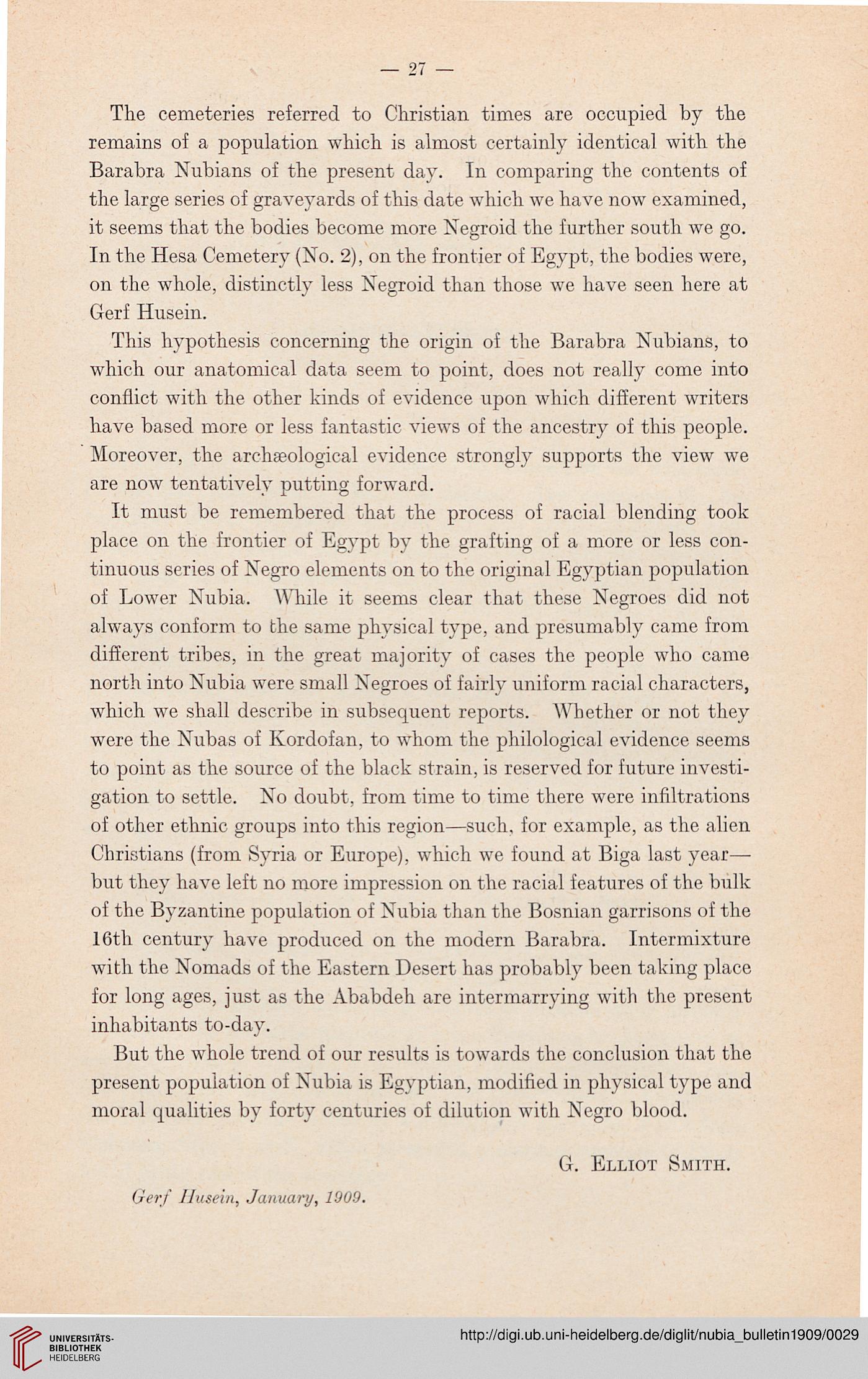The cemeteries referred to Christian times are occupied by the
remains of a population which is almost certainly identical with the
Barabra Nubians of the present day. In comparing the contents of
the large series of graveyards of this date which we have now examined,
it seems that the bodies become more Negroid the further south we go.
In the Hesa Cemetery (No. 2), on the frontier of Egypt, the bodies were,
on the whole, distinctly less Negroid than those we have seen here at
Gerf Husein.
This hypothesis concerning the origin of the Barabra Nubians, to
which our anatomical data seem to point, does not really come into
conflict with the other kinds of evidence upon which different writers
have based more or less fantastic views of the ancestry of this people.
Moreover, the archaeological evidence strongly supports the view we
are now tentatively putting forward.
It must be remembered that the process of racial blending took
place on the frontier of Egypt by the grafting of a more or less con-
tinuous series of Negro elements on to the original Egyptian population
of Lower Nubia. While it seems clear that these Negroes did not
always conform to the same physical type, and presumably came from
different tribes, in the great majority of cases the people who came
north into Nubia were small Negroes of fairly uniform racial characters,
which we shall describe in subsequent reports. Whether or not they
were the Nubas of Kordofan, to whom the philological evidence seems
to point as the source of the black strain, is reserved for future investi-
gation to settle. No doubt, from time to time there were infiltrations
of other ethnic groups into this region—such, for example, as the alien
Christians (from Syria or Europe), which we found at Biga last year—
but they have left no more impression on the racial features of the bulk
of the Byzantine population of Nubia than the Bosnian garrisons of the
16th century have produced on the modern Barabra. Intermixture
with the Nomads of the Eastern Desert has probably been taking place
for long ages, just as the Ababdeh are intermarrying with the present
inhabitants to-day.
But the whole trend of our results is towards the conclusion that the
present population of Nubia is Egyptian, modified in physical type and
moral qualities by forty centuries of dilution with Negro blood.
Gerf Husein, January, 1909.
G. Elliot Smith.
remains of a population which is almost certainly identical with the
Barabra Nubians of the present day. In comparing the contents of
the large series of graveyards of this date which we have now examined,
it seems that the bodies become more Negroid the further south we go.
In the Hesa Cemetery (No. 2), on the frontier of Egypt, the bodies were,
on the whole, distinctly less Negroid than those we have seen here at
Gerf Husein.
This hypothesis concerning the origin of the Barabra Nubians, to
which our anatomical data seem to point, does not really come into
conflict with the other kinds of evidence upon which different writers
have based more or less fantastic views of the ancestry of this people.
Moreover, the archaeological evidence strongly supports the view we
are now tentatively putting forward.
It must be remembered that the process of racial blending took
place on the frontier of Egypt by the grafting of a more or less con-
tinuous series of Negro elements on to the original Egyptian population
of Lower Nubia. While it seems clear that these Negroes did not
always conform to the same physical type, and presumably came from
different tribes, in the great majority of cases the people who came
north into Nubia were small Negroes of fairly uniform racial characters,
which we shall describe in subsequent reports. Whether or not they
were the Nubas of Kordofan, to whom the philological evidence seems
to point as the source of the black strain, is reserved for future investi-
gation to settle. No doubt, from time to time there were infiltrations
of other ethnic groups into this region—such, for example, as the alien
Christians (from Syria or Europe), which we found at Biga last year—
but they have left no more impression on the racial features of the bulk
of the Byzantine population of Nubia than the Bosnian garrisons of the
16th century have produced on the modern Barabra. Intermixture
with the Nomads of the Eastern Desert has probably been taking place
for long ages, just as the Ababdeh are intermarrying with the present
inhabitants to-day.
But the whole trend of our results is towards the conclusion that the
present population of Nubia is Egyptian, modified in physical type and
moral qualities by forty centuries of dilution with Negro blood.
Gerf Husein, January, 1909.
G. Elliot Smith.




